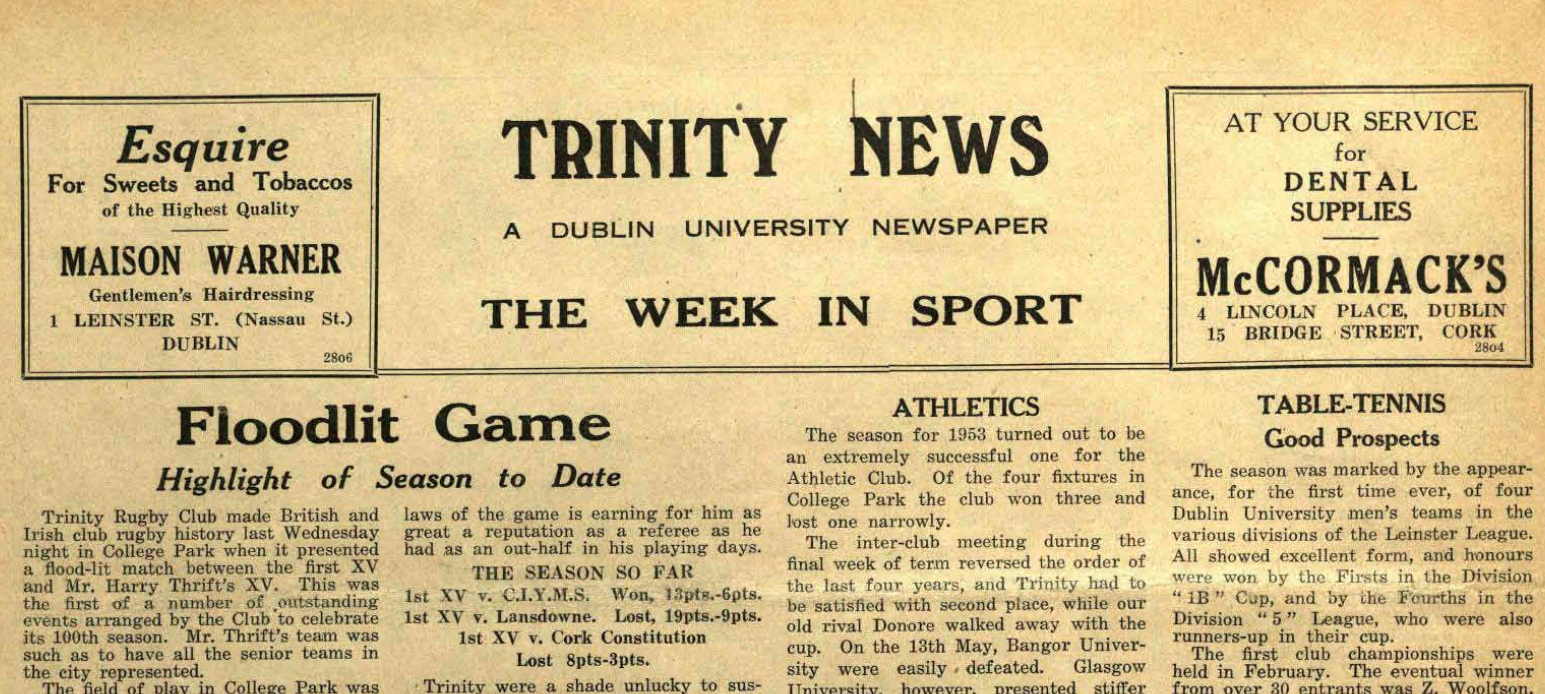The 28th of October marked the 70th anniversary of Trinity News and, along with it, Trinity News Sport. The first issue of Trinity News in 1973, subtitled ‘a Dublin University Weekly’, was a much smaller affair, only taking up six pages. However, as the subheading suggests, it came out every week for 3d, the same price the Irish Times retailed for in 1953. The front page headline of the day was a simple one, but one that today’s readers are used to; ‘Fees Increase’. Along with articles bemoaning fee increases, another institution of TN that has stood the test of time is the sport section’s place at the back pages.
Sporting adverts for Icarus and the now defunct Dublin Evening Mail, the headline of the back page was for a ‘Floodlit Game’ celebrating 100 years of DUFC. The match pitted the first XV against a XV selected by Harry Thrift. Born in 1882 and mentioned in James Joyce’s Ulysses, Harry Thrift was a sportsman, capped 18 times for the Irish rugby team between 1904 and 1909, before becoming a fellow at Trinity. Thrift founded DUCAC and would lead a central, if at times controversial, role in the organisation until 1952, when he was removed from his longstanding role as DUCAC Bursar. Unfortunately, the article wasn’t attributed to anyone in particular, but if anyone knows who may have wrote it, feel free to get in touch.
Floodlit Game, Highlight of Season to Date
Trinity Rugby Club made British and Irish club rugby history last Wednesday night in College Park when it presented a flood-lit match between the first XV and Mr. Harry Thrift’s XV. This was the first of a number of outstanding events arranged by the Club to celebrate its 100th season. Mr Thrift’s team was such as to have all the senior teams in the city represented.
The field of play in College Park was illuminated by fourteen 1,000 watt lamps suspended 20 feet above the pitch. A specially made fluorescent ball was used. The weather favoured the game. A mild, breezeless night attracted a record crowd to the Park to witness this unique venture. Generally speaking, the spectators were delighted with what they saw. The game under lamps looked to be exceedingly fast, and even if it was difficult to spot individual players at the far end of the field, the ball, oddly enough, was always clearly visible (well nearly!). Speaking to some of the players afterwards the only criticism I heard put forward was that the intensity of the light tended to vary from spot to spot and though one soon became accustomed to that it made it difficult to judge with accuracy the speed at which a player or the ball moved.
From start to finish the game was lively and full of interest, as someone remarked, “Brighter Rugby than usual.” There was an abundance of good clever back-play, handling was better than often seen in broad daylight; and we saw the wings used more often than on many a sunny Saturday. Kicking was reduced to a welcome minimum, but when used the flight of the ball even above the lights was easy to follow. The fielding of high balls was frequently fumbled due, mainly, to the difficulty in gauging the rate of descent of the ball. Under such strange conditions both sides did extremely well to produce such fine rugby. To a point to faults in the play would be very unfair. Let it suffice to record that the game was drawn six points all.
Before the match commenced the 30 players were presented to the President of the Leinster Branch of the Irish Rugby Football Union. The game was under the whistle of Rev. Austin Carry, a former Trinity star, whose intelligent interpretation and application of the laws of the game is earning for him as great a reputation as a referee as had as he had as an out-half in his playing days.






